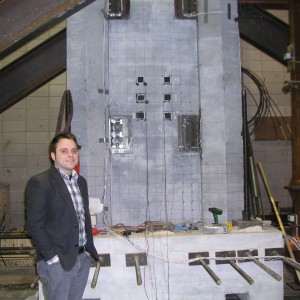 A project that started out as a side experiment to monitor bridge damages has since evolved into a revolutionary, cost-saving solution in the world of wind energy.
A project that started out as a side experiment to monitor bridge damages has since evolved into a revolutionary, cost-saving solution in the world of wind energy.
Simon Laflamme, assistant professor of civil, construction, and environmental engineering at Iowa State, began developing a damage-detecting polymer “skin” as a student at MIT.
The skin, which is made into about 3-inch square pieces, consists of an inexpensive polymer material sandwiched between a painted polymer mixed with carbon black to make it conductive, which allows it to send signals to computers monitoring for any distortions.
Once the skin is applied to a surface, it acts as a sensor that detects small cracks as it stretches. Its capacitance, or stored electrical charge, is measured as it changes.
Originally planning to use the skin for bridges because of his background in civil engineering, Laflamme traded bridges for wind turbines when he was hired by Iowa State in 2011.
He says this shift was partly due to a lack of long-term data on the potential return on investment from monitoring the solutions when applied to bridges. With wind energy, however, researchers can determine how much money a sensing skin could save over the next 20 years.
And, he adds, the research is promising. “With wind turbines as a good application for our technology, we started some more in-depth research on the skin to find out how it behaves, its applications, and optimization,” he says. “The idea was developed before I joined Iowa State, but now our understanding and research is really taking off with the wind industry.”
Because of the damage that occurs after years of fatigue from the load of the wind, turbine blades could greatly benefit from Laflamme’s sensing skin. The blades are hollow and composed of many sheets of materials glued together that can peel and crack over time—that’s where the sensing skin comes into play.
Like biological skin, the polymer material acts like a nervous system, sensing cracks in specific areas of the turbine blade like nerves would find a cut on a finger. Once damage is detected in real time, engineers can determine whether it needs to be fixed immediately or at all, which costs less than replacing a whole blade when it is beyond repair.
After the skin is applied and damage can be detected as it occurs, a pattern can be made to assess deterioration throughout the lifetime of a turbine. “The hope is to be able to do what we call a condition assessment—to be able to predict the future of the blade,” Laflamme says. “This way, engineers could look at how the blade behaves in the past to be able to predict the probabilities of failure and damage and to optimize maintenance operation on the blade.”
Laflamme identified maintenance as a big cost issue of wind turbines. His goal is to save money in the industry by improving the maintenance schedule, which would extend the life of a typical turbine beyond the average 20 years. He says this would, in effect, reduce the cost of wind energy production.
Applying his research to turbines has allowed Laflamme to span multiple fields of engineering. The skin itself is produced in collaboration with the materials science and engineering department, but it also has ties with electrical and computer engineering for designing cost-effective data acquisition systems, and various efforts have been undertaken with aerospace engineering, the Center for Nondestructive Evaluation, and the Bridge Engineering Center at InTrans.
Laflamme says the fact that this research has a multi-disciplinary approach is a great added benefit. “This is the future of engineering—especially civil engineering—to get all fields together and create solutions for our problems,” he adds.